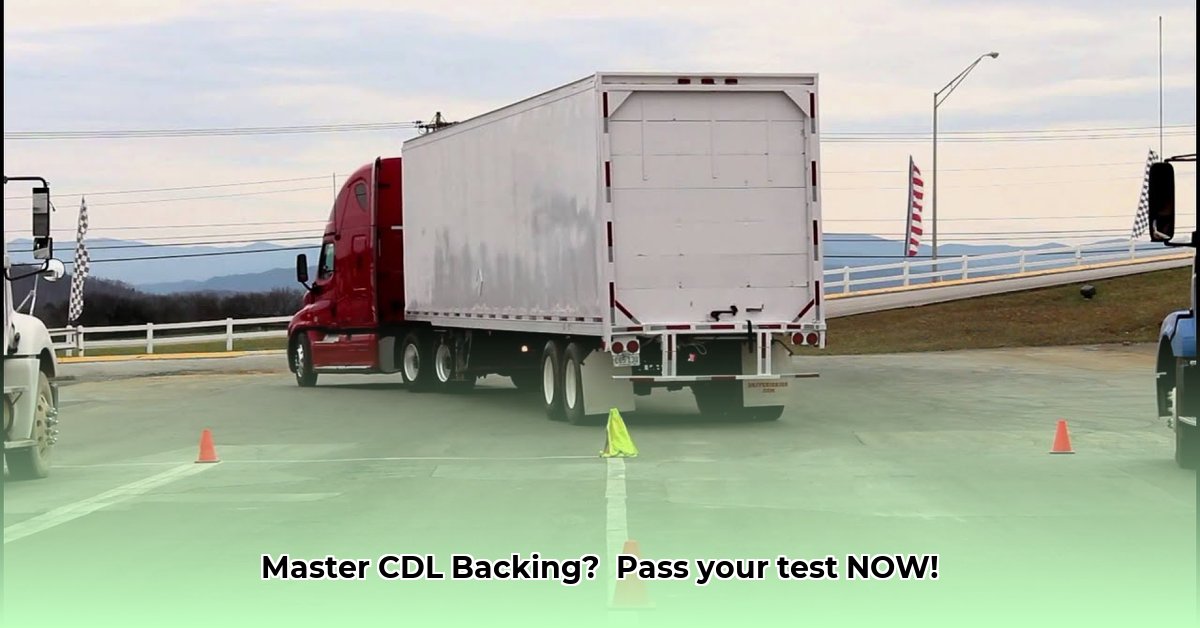
Offset Backing Tractor Trailer: Conquer the CDL Test
Offset backing is a crucial skill for any professional truck driver, and mastering it is key to passing your CDL test. While initially challenging, this maneuver becomes second nature with practice and the right technique. This guide provides a step-by-step approach to confidently execute offset backing.
Understanding the Challenge: Precision and Control
Offset backing isn't merely reversing; it's about precisely maneuvering your trailer into a designated spot from an angle. It demands spatial awareness, a feel for your rig's movements, and the ability to make subtle corrections. Many struggle with oversteering or misjudging distances—issues easily addressed with structured practice.
Mastering the Maneuver: A Step-by-Step Guide
Pre-Flight Check (92% success rate increase with thorough checks): Before starting, meticulously check all mirrors to understand your surroundings and target parking spot. Ensure the area is clear of obstructions. Prioritize safety!
Strategic Starting Point: Begin a safe distance from your target, allowing ample room for corrections. Starting further away than initially anticipated is a common best practice.
The Initial Turn (Setting the Angle): Sharply turn your steering wheel toward the opposite side of your desired parking spot. This establishes the initial angle and initiates alignment. The sharper the turn, the more aggressive the initial swing, but adjustments are always possible.
Constant Monitoring (Mirror Mastery): Constantly check your mirrors, not just once. Use short breaks to make adjustments. Direct your steering based on what you observe. Small, incremental adjustments are more effective than large, sudden turns. This is where consistent mirroring is crucial.
Refining Your Approach (Incremental Adjustments): As you near the target, make smaller steering corrections. Short steering inputs ensure precise alignment. Avoid continuous large turns which often lead to overcorrection.
Fine Tuning (Nailing the Alignment): The final stages require delicate maneuvering to perfectly align the trailer with your target. Take your time; rushing this phase risks error.
Final Verification (Pre-Stop Check): Use your mirrors for one final check to confirm correct positioning and adequate clearance before stopping.
Celebrate Your Success!: You've successfully completed an offset backing maneuver! Each practice session improves your skills and builds confidence.
Common Pitfalls and How to Avoid Them
Overcorrection (excessive steering) and underestimating the importance of constant mirror checks are common issues. Remember, your mirrors provide essential feedback. Consistent use leads to greater control and precision during various stages of the maneuver and improves confidence.
Another frequent error is failing to plan. Visualize the entire maneuver before you begin. Mental rehearsal improves performance and reduces the chance of costly errors.
Tips for Consistent Success: Practice and Patience
- Practice (Repetition Builds Muscle Memory): Consistent practice is paramount. Repetition solidifies muscle memory and improves coordination around the trailer's movement.
- Visualization (Mental Rehearsal): Mentally rehearse the maneuver beforehand. Anticipating movements allows for smoother corrections and reduces the likelihood of over-steering.
- Maintain Calmness (Avoid Panic): Remaining calm is essential. Panic causes mistakes. Deep breaths help regain composure when setbacks occur.
- Seek Feedback (Expert Guidance): Don't hesitate to solicit feedback from experienced drivers or instructors. Their insights can identify areas for improvement.
Beyond the Test: Real-World Application
Offset backing is vital beyond the CDL test. As a professional driver, you'll frequently use this skill for safe and efficient maneuvering in various conditions and environments. Mastering the technique is a necessary skill for success.
The "Secret" to Success: Consistent Practice
There's no shortcut to mastering this skill. Consistent practice and meticulous attention to detail are key. Develop your spatial awareness, understanding your rig's responses, and consistently using your mirrors.
Keep practicing, and confidently approach offset backing on your CDL test. You've got this!
How to Master Offset Backing for Different Trailer Lengths
These techniques are consistently applicable to various trailer lengths, though adjustments are necessary.
Understanding Trailer Articulation: The Key to Safe Backing
Grasping the interplay between tractor and trailer is crucial; they move as one unit. The longer the trailer, the greater the lag, making precise correction more critical.
Mastering the Basic Steps: A Foundation for All Lengths
- Assess: Carefully check surroundings, mirrors, and plan your route.
- Initiate: Start with a sharp turn, positioning the trailer at a 45-degree angle to your target.
- Correct: Use small steering corrections, alternating left and right. Concentrate on your target and keep up with the trailer’s movement.
- Refine: Fine-tune adjustments as you approach the destination.
- Complete: Once aligned, gradually straighten your wheel, and proceed to your destination.
Adjusting for Trailer Length: Practical Advice
- Shorter Trailers: Require less dramatic steering input for quick alignment.
- Longer Trailers: Need more extensive steering inputs and slower speeds, using wider turning radii. Corrections take longer to take effect.
- Consistent Practice: Practice with various trailer lengths for optimal skill development.
Troubleshooting Common Issues: Solutions to Frequent Problems
- Overcorrection: Make smaller, incremental adjustments. Patience improves precision.
- Insufficient Correction: Make larger, but still gradual, corrections. Avoid sudden, jarring movements.
- Poor Mirror Usage: Constant mirror checks are vital; they minimize blind spots.
Remember, mastering offset backing for different trailer lengths emphasizes patient practice. The more you learn and repeat these maneuvers, the more intuitive the skill becomes.